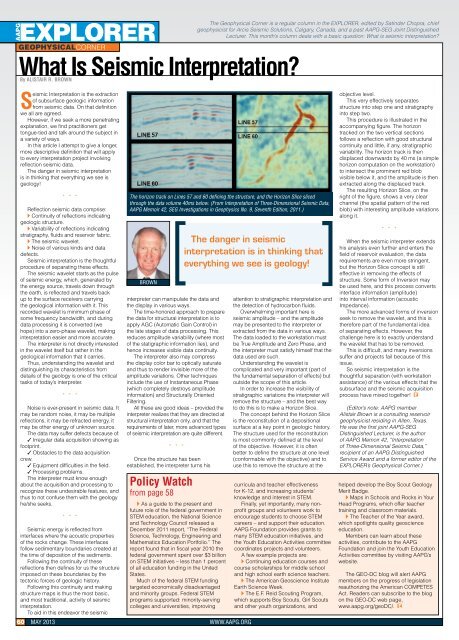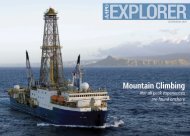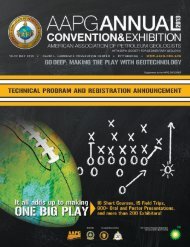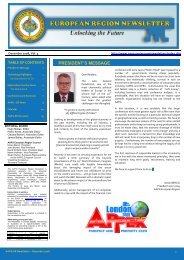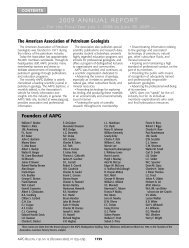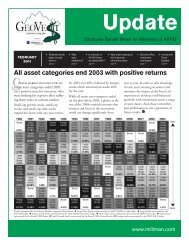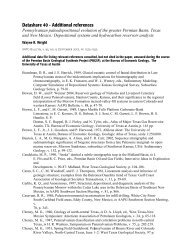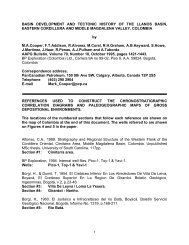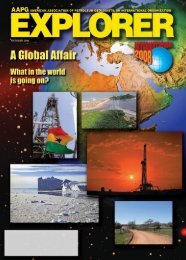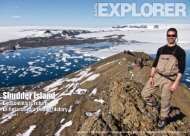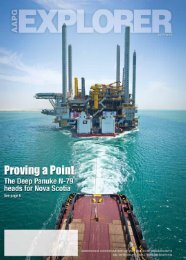Download - American Association of Petroleum Geologists
Download - American Association of Petroleum Geologists
Download - American Association of Petroleum Geologists
Create successful ePaper yourself
Turn your PDF publications into a flip-book with our unique Google optimized e-Paper software.
AAPG<br />
EXPLORER<br />
GEOPHYSICALCORNER<br />
The Geophysical Corner is a regular column in the EXPLORER, edited by Satinder Chopra, chief<br />
geophysicist for Arcis Seismic Solutions, Calgary, Canada, and a past AAPG-SEG Joint Distinguished<br />
Lecturer. This month’s column deals with a basic question: What is seismic interpretation?<br />
What Is Seismic Interpretation?<br />
By ALISTAIR R. BROWN<br />
Seismic Interpretation is the extraction<br />
<strong>of</strong> subsurface geologic information<br />
from seismic data. On that definition<br />
we all are agreed.<br />
However, if we seek a more penetrating<br />
explanation, we find practitioners get<br />
tongue-tied and talk around the subject in<br />
a variety <strong>of</strong> ways.<br />
In this article I attempt to give a longer,<br />
more descriptive definition that will apply<br />
to every interpretation project involving<br />
reflection seismic data.<br />
The danger in seismic interpretation<br />
is in thinking that everything we see is<br />
geology!<br />
* * *<br />
Reflection seismic data comprise:<br />
u Continuity <strong>of</strong> reflections indicating<br />
geologic structure.<br />
u Variability <strong>of</strong> reflections indicating<br />
stratigraphy, fluids and reservoir fabric.<br />
u The seismic wavelet.<br />
u Noise <strong>of</strong> various kinds and data<br />
defects.<br />
Seismic interpretation is the thoughtful<br />
procedure <strong>of</strong> separating these effects.<br />
The seismic wavelet starts as the pulse<br />
<strong>of</strong> seismic energy, which, generated by<br />
the energy source, travels down through<br />
the earth, is reflected and travels back<br />
up to the surface receivers carrying<br />
the geological information with it. This<br />
recorded wavelet is minimum phase <strong>of</strong><br />
some frequency bandwidth, and during<br />
data processing it is converted (we<br />
hope) into a zero-phase wavelet, making<br />
interpretation easier and more accurate.<br />
The interpreter is not directly interested<br />
in the wavelet itself but rather in the<br />
geological information that it carries.<br />
Thus, understanding the wavelet and<br />
distinguishing its characteristics from<br />
details <strong>of</strong> the geology is one <strong>of</strong> the critical<br />
tasks <strong>of</strong> today’s interpreter.<br />
* * *<br />
Noise is ever-present in seismic data. It<br />
may be random noise, it may be multiple<br />
reflections, it may be refracted energy, it<br />
may be other energy <strong>of</strong> unknown source.<br />
The data may suffer defects because <strong>of</strong>:<br />
3 Irregular data acquisition showing as<br />
footprint.<br />
3 Obstacles to the data acquisition<br />
crew.<br />
3 Equipment difficulties in the field.<br />
3 Processing problems.<br />
The interpreter must know enough<br />
about the acquisition and processing to<br />
recognize these undesirable features, and<br />
thus to not confuse them with the geology<br />
he/she seeks.<br />
* * *<br />
Seismic energy is reflected from<br />
interfaces where the acoustic properties<br />
<strong>of</strong> the rocks change. These interfaces<br />
follow sedimentary boundaries created at<br />
the time <strong>of</strong> deposition <strong>of</strong> the sediments.<br />
Following the continuity <strong>of</strong> these<br />
reflections then defines for us the structure<br />
imposed on these boundaries by the<br />
tectonic forces <strong>of</strong> geologic history.<br />
Following this continuity and making<br />
structure maps is thus the most basic,<br />
and most traditional, activity <strong>of</strong> seismic<br />
interpretation.<br />
To aid in this endeavor the seismic<br />
The horizon track on Lines 57 and 60 defining the structure, and the Horizon Slice sliced<br />
through the data volume 40ms below. (From Interpretation <strong>of</strong> Three-Dimensional Seismic Data,<br />
AAPG Memoir 42, SEG Investigations in Geophysics No. 9, Seventh Edition, 2011.)<br />
BROWN<br />
interpreter can manipulate the data and<br />
the display in various ways.<br />
The time-honored approach to prepare<br />
the data for structural interpretation is to<br />
apply AGC (Automatic Gain Control) in<br />
the late stages <strong>of</strong> data processing. This<br />
reduces amplitude variability (where most<br />
<strong>of</strong> the statigraphic information lies), and<br />
hence increases visible data continuity.<br />
The interpreter also may compress<br />
the display color bar to optically saturate<br />
and thus to render invisible more <strong>of</strong> the<br />
amplitude variations. Other techniques<br />
include the use <strong>of</strong> Instantaneous Phase<br />
(which completely destroys amplitude<br />
information) and Structurally Oriented<br />
Filtering.<br />
All these are good ideas – provided the<br />
interpreter realizes that they are directed at<br />
structural interpretation only, and that the<br />
requirements <strong>of</strong> later, more advanced types<br />
<strong>of</strong> seismic interpretation are quite different.<br />
* * *<br />
Once the structure has been<br />
established, the interpreter turns his<br />
Policy Watch<br />
from page 58<br />
u As a guide to the present and<br />
future role <strong>of</strong> the federal government in<br />
STEM education, the National Science<br />
and Technology Council released a<br />
December 2011 report, “The Federal<br />
Science, Technology, Engineering and<br />
Mathematics Education Portfolio.” The<br />
report found that in fiscal year 2010 the<br />
federal government spent over $3 billion<br />
on STEM initiatives – less than 1 percent<br />
<strong>of</strong> all education funding in the United<br />
States.<br />
Much <strong>of</strong> the federal STEM funding<br />
targeted economically disadvantaged<br />
and minority groups. Federal STEM<br />
programs supported: minority-serving<br />
colleges and universities, improving<br />
60 MAY 2013 WWW.AAPG.ORG<br />
The danger in seismic<br />
interpretation is in thinking that<br />
everything we see is geology!<br />
attention to stratigraphic interpretation and<br />
the detection <strong>of</strong> hydrocarbon fluids.<br />
Overwhelming important here is<br />
seismic amplitude – and the amplitude<br />
may be presented to the interpreter or<br />
extracted from the data in various ways.<br />
The data loaded to the workstation must<br />
be True Amplitude and Zero Phase, and<br />
the interpreter must satisfy himself that the<br />
data used are such.<br />
Understanding the wavelet is<br />
complicated and very important (part <strong>of</strong><br />
the fundamental separation <strong>of</strong> effects) but<br />
outside the scope <strong>of</strong> this article.<br />
In order to increase the visibility <strong>of</strong><br />
stratigraphic variations the interpreter will<br />
remove the structure – and the best way<br />
to do this is to make a Horizon Slice.<br />
The concept behind the Horizon Slice<br />
is the reconstitution <strong>of</strong> a depositional<br />
surface at a key point in geologic history.<br />
The structure used for the reconstitution<br />
is most commonly defined at the level<br />
<strong>of</strong> the objective. However, it is <strong>of</strong>ten<br />
better to define the structure at one level<br />
(conformable with the objective) and to<br />
use this to remove the structure at the<br />
curricula and teacher effectiveness<br />
for K-12, and increasing students’<br />
knowledge and interest in STEM.<br />
Finally, yet importantly, many nonpr<strong>of</strong>it<br />
groups and volunteers work to<br />
encourage students to choose STEM<br />
careers – and support their education.<br />
AAPG Foundation provides grants to<br />
many STEM education initiatives, and<br />
the Youth Education Activities committee<br />
coordinates projects and volunteers.<br />
A few example projects are:<br />
u Continuing education courses and<br />
course scholarships for middle school<br />
and high school earth science teachers.<br />
u The <strong>American</strong> Geoscience Institute<br />
Earth Science Week.<br />
u The E.F. Reid Scouting Program,<br />
which supports Boy Scouts, Girl Scouts<br />
and other youth organizations, and<br />
objective level.<br />
This very effectively separates<br />
structure into step one and stratigraphy<br />
into step two.<br />
This procedure is illustrated in the<br />
accompanying figure. The horizon<br />
tracked on the two vertical sections<br />
follows a reflection with good structural<br />
continuity and little, if any, stratigraphic<br />
variability. The horizon track is then<br />
displaced downwards by 40 ms (a simple<br />
horizon computation on the workstation)<br />
to intersect the prominent red blob<br />
visible below it, and the amplitude is then<br />
extracted along the displaced track.<br />
The resulting Horizon Slice, on the<br />
right <strong>of</strong> the figure, shows a very clear<br />
channel (the spatial pattern <strong>of</strong> the red<br />
blob) with interesting amplitude variations<br />
along it.<br />
* * *<br />
When the seismic interpreter extends<br />
his analysis even further and enters the<br />
field <strong>of</strong> reservoir evaluation, the data<br />
requirements are even more stringent,<br />
but the Horizon Slice concept is still<br />
effective in removing the effects <strong>of</strong><br />
structure. Some form <strong>of</strong> Inversion may<br />
be used here, and this process converts<br />
interface information (amplitude)<br />
into interval information (acoustic<br />
Impedance).<br />
The more advanced forms <strong>of</strong> inversion<br />
seek to remove the wavelet, and this is<br />
therefore part <strong>of</strong> the fundamental idea<br />
<strong>of</strong> separating effects. However, the<br />
challenge here is to exactly understand<br />
the wavelet that has to be removed.<br />
This is difficult, and many inversions<br />
suffer and projects fail because <strong>of</strong> this<br />
issue.<br />
So seismic interpretation is the<br />
thoughtful separation (with workstation<br />
assistance) <strong>of</strong> the various effects that the<br />
subsurface and the seismic acquisition<br />
process have mixed together!<br />
(Editor’s note: AAPG member<br />
Alistair Brown is a consulting reservoir<br />
geophysicist residing in Allen, Texas.<br />
He was the first joint AAPG-SEG<br />
Distinguished Lecturer, is the author<br />
<strong>of</strong> AAPG Memoir 42, “Interpretation<br />
<strong>of</strong> Three-Dimensional Seismic Data,”<br />
recipient <strong>of</strong> an AAPG Distinguished<br />
Service Award and a former editor <strong>of</strong> the<br />
EXPLORER’s Geophysical Corner.)<br />
helped develop the Boy Scout Geology<br />
Merit Badge.<br />
u Maps in Schools and Rocks in Your<br />
Head Programs, which <strong>of</strong>fer teacher<br />
training and classroom materials.<br />
u The Teacher <strong>of</strong> the Year award,<br />
which spotlights quality geoscience<br />
education.<br />
Members can learn about these<br />
activities, contribute to the AAPG<br />
Foundation and join the Youth Education<br />
Activities committee by visiting AAPG’s<br />
website.<br />
The GEO-DC blog will alert AAPG<br />
members on the progress <strong>of</strong> legislation<br />
reauthorizing the <strong>American</strong> COMPETES<br />
Act. Readers can subscribe to the blog<br />
on the GEO-DC web page,<br />
www.aapg.org/geoDC/.<br />
EXPLORER<br />
EXPLORER


